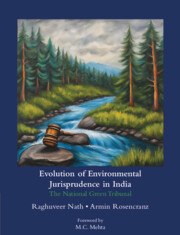Book contents
- Frontmatter
- Dedication
- Contents
- List of Images
- Foreword
- Preface
- Acknowledgements
- List of Abbreviations
- 1 Introduction to the National Green Tribunal: The Need for a “Green Court”
- 2 The National Green Tribunal Act, 2010: Analysis and Interpretation
- 3 Interpretation and Application of Environmental Principles
- 4 Evaluating the National Green Tribunal after a Decade: Challenges to Overcome
- Interview with Justice Swatanter Kumar
- Interview with Vimal Bhai
- Index of Cases
4 - Evaluating the National Green Tribunal after a Decade: Challenges to Overcome
Published online by Cambridge University Press: 15 January 2025
- Frontmatter
- Dedication
- Contents
- List of Images
- Foreword
- Preface
- Acknowledgements
- List of Abbreviations
- 1 Introduction to the National Green Tribunal: The Need for a “Green Court”
- 2 The National Green Tribunal Act, 2010: Analysis and Interpretation
- 3 Interpretation and Application of Environmental Principles
- 4 Evaluating the National Green Tribunal after a Decade: Challenges to Overcome
- Interview with Justice Swatanter Kumar
- Interview with Vimal Bhai
- Index of Cases
Summary
It has been a decade since the NGT Act was enacted by the parliament. As discussed in Chapter 1, however, this enactment was primarily a result of judicial assertion rather than legislative will. The Supreme Court, throughout the 1980s up till the early 2000s, tackled environmental degradation and pollution through the process of public interest litigation. This process allowed the Court to provide wider remedies by way of procedural innovations such as the expansion of locus standi through the introduction of epistolary jurisdiction, introduction of a non-adversarial procedure, and ensuring monitoring and implementation of orders through continuing mandamus. While most of the present environmental jurisprudence came from this, the Court found it increasingly difficult to adjudicate complex scientific and technical issues involved in environmental cases. In addition, the Court found itself increasingly indulging in fact-finding and evidence collection since writ petitions under the expanded locus standi were accepted without the requirement of much proof. Frequently, the Court would overstep its constitutional boundaries and enter into regulatory, administrative, and policymaking domains to meet the ends of justice.
Accordingly, as discussed previously, the Supreme Court, through four major decisions, called for the creation of the NGT by voicing the urgent need for a “green tribunal”. Further, the 186th Report of the Law Commission of India recommended the establishment of “environmental courts” in every state, which would be composed of judges as well as experts and would have both original and appellate jurisdiction.
However, the lack of legislative will in this regard was evident from the failures of the NGT's predecessors – the NET and the NEAA. These tribunals were made toothless due to a lack of appointments and funding. The NET remained on paper as the NET Act, 1995, was never notified, and the NEAA remained without a chairperson for almost a decade. In fact, at one point in time, the NEAA had only one member who was also its chairperson. Nevertheless, due to the concern voiced by the Supreme Court and the Law Commission, coupled with the need to give effect to India's obligations under the Stockholm and Rio Declarations, the Indian legislature enacted the NGT Act.
- Type
- Chapter
- Information
- Evolution of Environmental Jurisprudence in IndiaThe National Green Tribunal, pp. 362 - 394Publisher: Cambridge University PressPrint publication year: 2025

